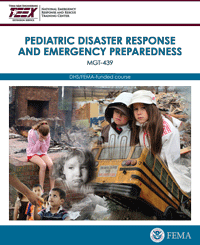South Carolina Coalition formed to address pediatric disaster planning
Officials in South Carolina have formed a coalition to improve preparedness for children involved in disaster, thanks, in part, to training offered by the Texas A&M Engineering Extension Service (TEEX). A new statewide Pediatric Disaster Planning Coalition held its first meeting on May 9.
 The impetus for the coalition was a DHS/FEMA-funded class in Pediatric Disaster Response and Emergency Preparedness held in Myrtle Beach, prior to the South Carolina Emergency Care Symposium in February.
The impetus for the coalition was a DHS/FEMA-funded class in Pediatric Disaster Response and Emergency Preparedness held in Myrtle Beach, prior to the South Carolina Emergency Care Symposium in February.
“During the class, we were able to see deficiencies we have, and I think it brought attention to things we needed to work on and questions we didn’t know the answers to,” said Karen Moore, EMS for Children Program Coordinator in the S.C. Department of Health and Environmental Control, Division of Trauma.
Moore and others in the class saw an opportunity to build consensus among key stakeholders to develop a new pediatric disaster plan for the state. She and other class participants gathered after hours to discuss ways to begin taking the planning steps they were discussing in the class. The Pediatric Disaster Planning Working Group was born.
The group soon hatched a plan for a statewide coalition and set the date for the initial meeting. On May 9, a group of stakeholders met in person and by conference call to establish a coalition to tackle the needs identified in the class. The coalition includes stakeholders from many areas that are involved in pediatric disaster planning, including EMS and hospital personnel, law enforcement, principals and school resource officers, and the Red Cross.
 “We had a successful coalition meeting,” Moore said. “The TEEX course provided the tools we needed to begin this endeavor. The knowledgeable instructors provided the information and helped us pinpoint areas where our plan had deficiencies, and answered the multiple questions we had. The class was also a good way to network and learn what the other people and their agencies could provide. Sometimes it is just knowing who to call. We made lists, and brainstormed about who else we should bring to the table to work on the pediatric disaster plan. The instructor, Laura Prestidge, helped by providing a list used by another state.
“We had a successful coalition meeting,” Moore said. “The TEEX course provided the tools we needed to begin this endeavor. The knowledgeable instructors provided the information and helped us pinpoint areas where our plan had deficiencies, and answered the multiple questions we had. The class was also a good way to network and learn what the other people and their agencies could provide. Sometimes it is just knowing who to call. We made lists, and brainstormed about who else we should bring to the table to work on the pediatric disaster plan. The instructor, Laura Prestidge, helped by providing a list used by another state.
“We have been pushing this and tried in the past to put together a coalition, but this course ignited the spark we needed. This time, the message was coming from the experts at TEEX and they were pointing out things we needed to work on.”
Moore said the TEEX instructors, Prestidge and Glenn Miller, have continued to support their effort. “When they say you can contact us after the class, they really mean it!”
About the Course
Pediatric Disaster Response and Emergency Preparedness (MGT439) is funded by the DHS/FEMA Homeland Security National Training Program Cooperative Agreement and offered nationwide at no cost to qualified participants. More than 2,000 healthcare and emergency response personnel across the nation have attended the course in the past two years.
